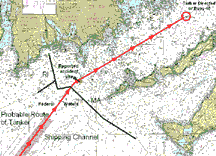Accident Summary
Bouchard No. 120
[This is an unofficial summary based on press reports, publicly released Coast Guard information and other documentation. The map shown was based on coordinates contained in a transcript published in Newspapers on June 5, 2003. ]
On Sunday afternoon, April 27, 2003, the tugboat Evening Tide was towing the unmanned fuel barge, Bouchard No. 120 with a 1200-foot cable approaching Buzzards Bay from the south. According to the Bouchard website, Barge No. 120 was built in 1975, is 376 feet long, and has a maximum capacity of 120,000 barrels (5 million gallons). On this day, the barge contained 4.1 million gallons of Number 6 fuel oil.
Another tug boat captain observed a sheen of oil behind the barge that afternoon. At 5:30 PM Sunday, the Evening Star captain called the Coast Guard MSO office in Providence to report a sheen of oil behind his barge. It would be later determined the sheen was the result of a 12-foot by 2-foot gash on the bottom of the barge. The first press reports indicated that the barge was somewhere outside of Buzzards Bay at 5:30 PM Sunday, possibly even in Rhode Island waters, but it is now believed that the tank barge grounded just north of Buoy G1 at the entrance of Buzzards Bay. This site is in Massachusetts’s waters, but is technically in the body of water called Rhode Island Sound on nautical charts.
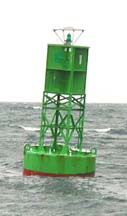 Buoy (ISO G1) near the entrance of Buzzards Bay (south of Gooseberry Point) where the accident occurred. The tank barge likely traveled a couple hundred feet left of this buoy, instead of passing to the right. ISO stands for isophase (the light blinks an equal length of time on and off). Photo Credit: Dr. Joe Costa.
Buoy (ISO G1) near the entrance of Buzzards Bay (south of Gooseberry Point) where the accident occurred. The tank barge likely traveled a couple hundred feet left of this buoy, instead of passing to the right. ISO stands for isophase (the light blinks an equal length of time on and off). Photo Credit: Dr. Joe Costa.A newspaper report a week after the accident in the New Bedford Standard Times stated that eyewitnesses observed the Bouchard barge in Buzzards Bay five hours earlier at Anchorage Lima than reported to the Coast Guard. These reports were rebutted by the Bouchard company on May 2. They indicated that Bouchard Barge No. 80, a similar looking vessel, was coincidentally at Buoy 10 that same afternoon, waiting entry to the Cape Cod Canal. Newspapers later reported that the Army Corps confirmed the entry of Barge No. 80 earlier that day in the canal.
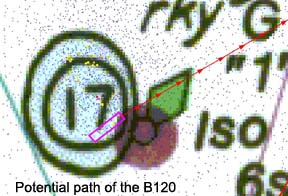
If the barge struck bottom near buoy G1, it would have had to travel nearly 11.5 miles to reach buoy BB where it was first reported anchored, and 16 miles total to reach the anchorage at buoy 10. This latter anchorage area is also called “Anchorage Lima”, and is in central Buzzards Bay, about 5 miles WNW of Woods Hole in Falmouth and 3 Miles SE of West Island in Fairhaven. However, subsequent transcripts place the Bouchard No. 120 dead in the water near buoy “BB”, 4.5 miles SW of Anchorage Lima, near buoy BB, probably at 5:30 PM, the time of the first call to the Coast Guard. At a subsequent public meeting, a Coast Guard official stated that the tugboat towing the Bouchard No. 120 tank barge was apparently initially unaware of the vessel striking bottom.
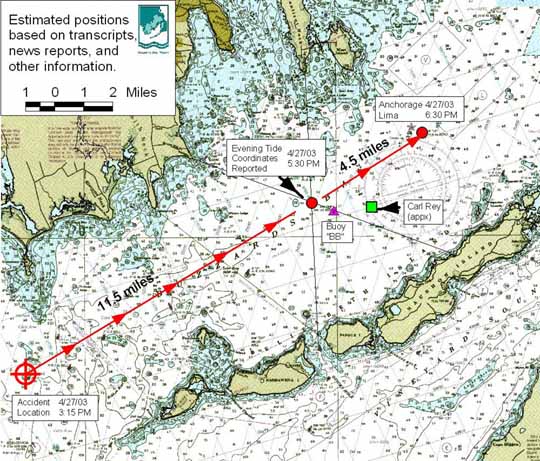
The time of the accident coincided with low tide, and average wave height was 4.7 feet, and winds were around 15 miles per hour coming from North of Northwest.
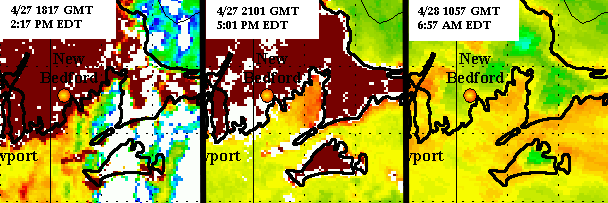
Not long after the spill, the Buzzards Bay NEP contacted several agencies managing satellite data, including the European Space Agency, which had a high-resolution LIDAR satellite that could have actually imaged the barge in Buzzards Bay had it been overhead. However, it appears that no high-resolution satellites were overhead at the time of the accident. However, we did obtain the above lower resolution thermal images from the Rutgers University Coastal Ocean Observation laboratory, which had satellite images taken before and after the accident. The resolution of this image is far to crude to show the vessel, or oil spill, however it does show outgoing cloud cover the morning before the accident. The digital coastline is not perfectly registered with the thermal image, and the warm “dot” in southern Buzzards Bay in the 5:01 PM photograph is probably Penikese Island, not the Bouchard No. 120.
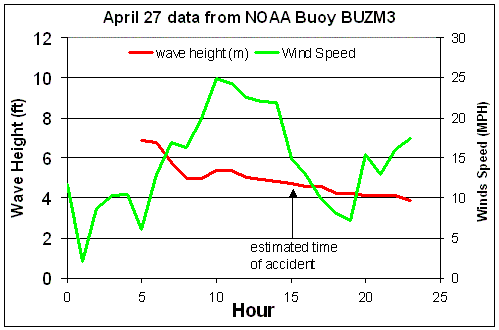
The original report of a “sheen” of oil by the Captain was thought to be initially confirmed by a helicopter survey by a federal Hazmat team about 7:10 PM Sunday, near sunset. A sheen is a very thin film of oil, but with darkening conditions, the survey did not recognize that a sizable “slick,” not a sheen, trailed the barge. It was not until 2:30 AM Monday, that divers determined the severity of the spill when they discovered the damage on the bottom of the barge and Bouchard estimated the missing oil volume based on level meters in the barge compartments. The starboard storage tank was reported ruptured on the bottom of the hull below the water, with damage consistent with striking bottom. On Monday morning, the Coast Guard reported Bouchard’s estimate of 14,700 gallons had already spilled from the 12-foot by 2-foot gash on the underside of the barge. However, on Tuesday May 20, the Bouchard Transportation Company revised its estimate to 98,000 gallons based on the amount of oil pumped off the vessel two weeks earlier.
The 28-year-old single hulled barge is the Bouchard No. 120, owned by Bouchard Transportation Co. Inc. The oil barge was en route from Philadelphia to the Mirant Power Generating facility in Sandwich, which is located along the Cape Cod Canal.
The Coast Guard arrived on scene the evening of April 27. In the early morning of April 28, the Massachusetts DEP, the US Coast Guard, and a private cleanup company on contract with the state called Clean Harbors, arrived on scene. The US Coast Guard boomed the vessel late Sunday and early Monday morning and fully contained the remaining oil on the barge. On April 28, another tank barge, the Bouchard No. 10, offloaded some oil and water off the Bouchard No. 120. The Coast Guard initially used several skimmers to clean up oil in the first week after the spill.
That first morning, the Buzzards Bay Municipal Oil Spill Coordinators were mobilized across Buzzards Bay. The Buzzards Bay Coalition began using citizen volunteers to act as spotters for oil landings on the coast and to assist in animal rescue.
Coast Guard Time Line
The official Coast Guard Timeline, posted in a press release is as follows:
Buzzard’s Bay Oil Spill Response Timeline:
April 27, 2003
5:30 p.m. Coast Guard Marine Safety Office (MSO) Providence received initial report that a barge was leaking an unknown amount of oil 5:30 p.m. — MSO Providence, Clean Harbors and Marine Spill Response Corporation (MSRC) began mobilizing response personnel and equipment 6:31 p.m. — Bouchard reports barge conducting internal transfer from #2 starboard cargo tank. Bouchard stages 2,000 feet of shoreline protection boom at Woods Hole.
7:12 p.m. — Coast Guard Group Woods Hole 41-foot boat on scene
7:20 p.m. – Coast Guard Air Station Cape Cod helicopter on scene
8:20 p.m. — MSO Providence on scene
9 p.m. — Coast Guard Brief NOAA scientific support coordinator Steve Lehmann
10:06 p.m. — Briefed Mass. Dept. of Environmental Protection
10:50 p.m. — Divers from Clean Harbors arrive on scene and commence initial hull assessment
11:35 p.m. — Tug Jaguar arrives on scene with 1500 feet of 16″ boom, begins deploying around the barge
April 28, 2003
12:35 a.m. — Divers report 11′-12′ longitudinal fracture in hull
1:44 a.m. — Bouchard positions 2,000 feet of boom at the Mass. Maritime Academy for shoreline protection
2:50 a.m. — Incident Command System implemented
7:15 a.m. — Overflight departs from Air Station Cape Cod with Federal On-Scene Commander Captain Mary Landry, NOAA scientific support coordinator and Bob Donovan aboard
7:40 a.m. — Maine Responder arrives on scene in Buzzards Bay
9 a.m. — Unified Command Requests Coast Guard Atlantic Strike Team
Links
Official National Response Center Incident Log with times
Note: There are 42 gallons in a barrel of oil.
Official National Response Center summary for Bouchard No. 120
